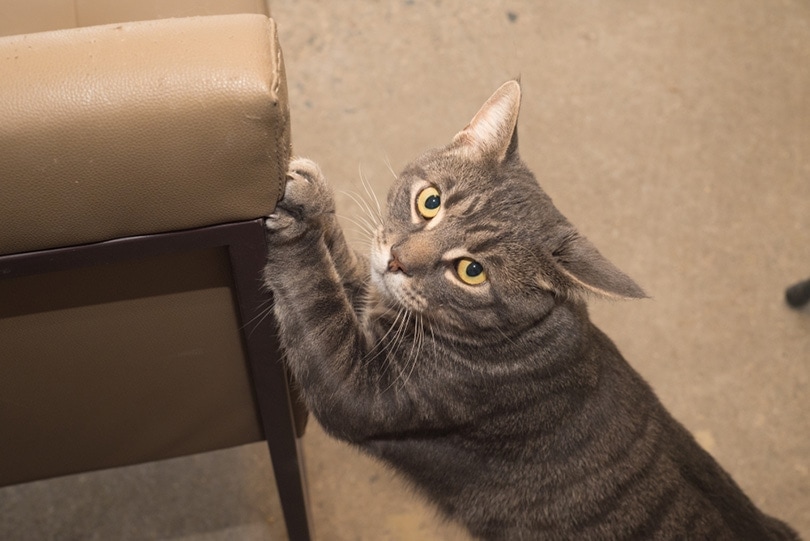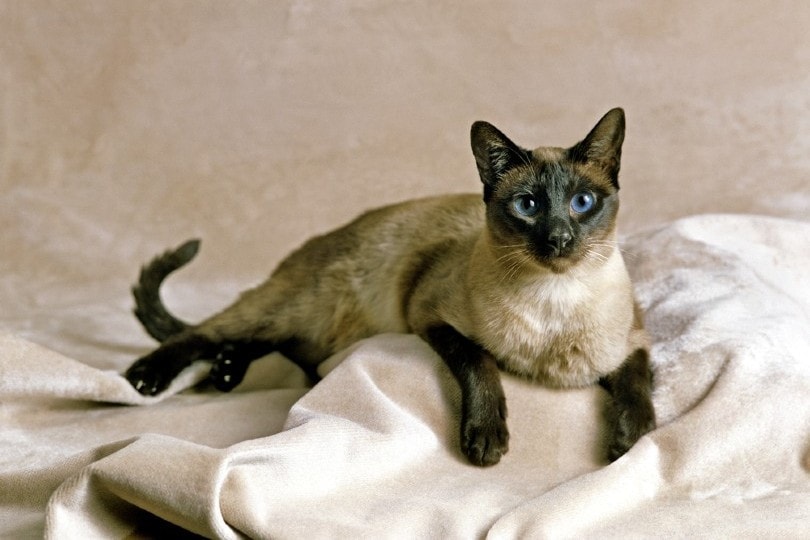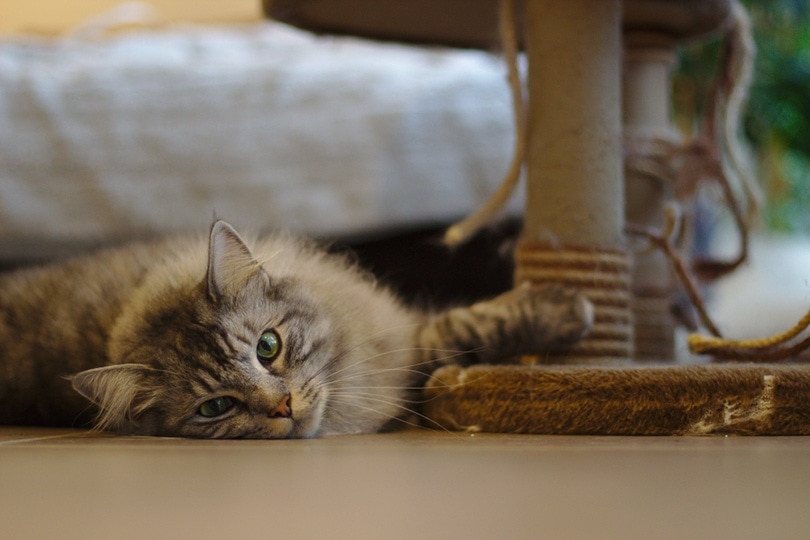How to Cat-Proof Furniture? 8 Effective Ways

Updated on

Despite all the positives surrounding pets, there are several downsides too. Finding the shredded remains of your couch when you return home from work is only one of them. Everyone knows that dogs chew things, but cats can be just as destructive.
Not only do cats climb everything and tend to knock things flying, but they also take good care of their claws. While this means you don’t often have to tend to them yourself, it can mean disaster for the leg of your dining table.
To protect your furniture, whether it’s brand-new or a family heirloom, here’s a list of ways to cat-proof your home.
 Top 8 Ways to Cat-Proof Furniture:
Top 8 Ways to Cat-Proof Furniture:
1. Cat Scratch Spray or Tape
Cat scratch sprays are available in stores or can be made at home. They’re designed to make your cat believe that they’ve already marked the piece of furniture as part of their territory. This option does have a downside, though. Sprays are a temporary measure, and you’ll need to remember to reapply the scent every day.
A similar option is double-sided tape. You can buy panels or rolls, stick them to your furniture, and peel them off when no longer needed. Cats dislike it when textures interfere with their feet, and the stickiness of double-sided tape is a deterrent. While tape doesn’t need to be reapplied as frequently as sprays, it does collect dirt and debris.
- Works on most surfaces
- Sprays need to be applied daily
- Tape can collect dirt and hair

2. Citrus or Apple Cider Vinegar
Some sprays can be harmful to our pets, but certain homemade solutions can work just as well. Try filling a spray bottle with diluted lemon or lime juice, and spritz it over your furniture. You can do the same thing with apple cider vinegar. Both smells are disliked by felines, and they’ll avoid the location until the scent fades.
However, there is a caveat to this. Some fabrics are hardier than others, and both these options are acidic. Test a small, inconspicuous area first to make sure you don’t inadvertently damage your fabric couch in your attempt to protect it.
- Can be made at home
- Cats dislike the smell of citrus and apple cider vinegar
- Can damage certain materials
3. Claw Care
Many people use their cat’s tendency to scratch as a reason to get them declawed. This is never a recommended solution and can cause your cat a great deal of pain. Instead, try these more humane solutions that will keep your cat happy and your furniture intact.
Nail Trimming
If you own dogs, you’re no doubt familiar with the need to keep their claws clipped. Cats don’t often need our assistance. However, you can help keep them trimmed to avoid them shredding the legs of your table or the side of your sofa. You’ll need to get your cat used to the process when they’re young, though.
Nail Caps
A temporary and harmless solution for your cat is getting soft nail caps. They’re easy to use and last for about a month. For indoor cats, they’re a great way to reduce the damage done by their clawing tendencies while you teach them which places are acceptable to scratch.
- No declawing necessary
- Humane
- Nail caps are temporary
- Some older cats won’t like having their nails trimmed

4. Pheromones
Specific scents can calm your cat and make them more likely to take a nap rather than wreak havoc. You can purchase pheromones that you can plug into a wall socket that will subtly protect your furniture.
The right scent can also help ease any anxiety that your cat might be feeling due to a guest, a house move, or loud noises. Anxious kitties can cause a great deal of damage through scratching or by relieving themselves on your best rug. Calming them down with carefully selected pheromones can help reduce the chances of both these issues occurring.
- Relaxes your cat
- Suitable for multi-cat households
- Not all scents are pet-friendly
5. Reduce Boredom
Sometimes, your cat scratches your furniture while they’re playing. If they’re bored enough, using the couch as a climbing frame is an easy source of amusement.
You can reduce your cat’s boredom by supplying various toys and activities for them to enjoy. Puzzle games that enable them to seek out treats and independent cat toys will keep them entertained while you’re at work. A well-placed cat tree by a window overlooking your yard can help too, as the view will do the hard work for you.
Engaging in regular playtimes with your cat can alleviate boredom too. You’ll be able to wear them out and relieve some of your own stress at the same time, without risking your furniture.
- Playing with your cat is a good way to bond
- Not a fool-proof solution

6. Scratching Posts
Preventing your cat from scratching your furniture is sometimes as simple as giving them something that they’re allowed to scratch. Scratching posts come in a range of sizes for all sorts of households. There are several textures available to suit your fussy feline’s preferences. You can even make a DIY option with cardboard or sisal rope.
Having several scratching posts will give your cat plenty of options. You can also reinforce the behavior by rewarding your kitty when they scratch the correct spots.
- Supplies more suitable scratching spots for your cat
- Can be made at home
- Scratching posts can be expensive
7. Velvet
Velvet might seem delicate with its use in elegant décor, but it’s actually incredibly hardy. Against cats, it’s a game-changer. Made up of looped threads, a velvet couch or velvet-covered seat cushions are much harder for your cat to sink their claws into. The difficulty means your cat is less likely to damage your couch by scratching.
Velvet furniture does have its cons, though. Not only are they on the expensive side, but they’re also notoriously hard to clean and can be a little ostentatious for a casual aesthetic.
- Tough for cats to scratch
- Expensive

8. Vinyl Guards
There are many solutions to the issues of cat scratching. Vinyl guards are similar to tape, but they rely on a smooth finish rather than stickiness to prevent your cat from scratching your furniture.
The idea is that you apply clear vinyl panels to the arms of your couch or table legs, so your cat can’t sink their claws into the material. The guards also prevent them from being able to climb up it. You can buy options that screw into place or have sticky backs.
- Stops your cat clawing furniture
- Glue might damage certain materials
Why Do Cats Scratch Furniture?
As annoying as the habit is for us, cats scratch furniture for more reasons than to just maintain their claws. It’s also a way for them to mark their territory, release tension, and stretch after a long nap.
While you consider your couch to be an aesthetically pleasing comfort that looks better intact, your cat sees it as little more than an object to scratch.

The Issues With Declawing
Declawing used to be more popular, but these days, many cat owners and veterinarians advocate against the idea. The surgery isn’t as simple as removing their claws alone and requires amputating the last bone in their toes.
Not only is the surgery itself painful, but it also causes a lasting discomfort whenever your cat uses their paws. If you have an indoor cat that uses a litter tray, it can mean that your kitty finds it difficult to dig properly. The pain can be off-putting enough that they’ll be more likely to do their business on your carpet.
There’s also an issue for outdoor cats. A cat’s claws are how they hunt and defend themselves. Without them, if your kitty gets into trouble with a feral cat or even a dog, they’ll have no way to protect themselves.
In the end, it’s far more humane to consider other, less painful options. Nail caps for their claws or vinyl guards for your furniture are both harmless options that are completely cat-friendly.
 Conclusion
Conclusion
Pets, even house-trained, can be surprisingly destructive. If you’re away at work all day, it’s impossible to stop your cat from scrambling up the back of your couch or play-fighting on your bed.
To protect your furniture, try these tips. With trial and error, you’ll find the solution that works best for you.
See also:
- How to Kitten-Proof Your Home: 13 Simple Tips
- 7 Best Cat-Proof Furniture Pieces – Reviews & Top Picks
Featured Image Credit: Melissa Sue, Shutterstock
 Top 8 Ways to Cat-Proof Furniture:
Top 8 Ways to Cat-Proof Furniture:









